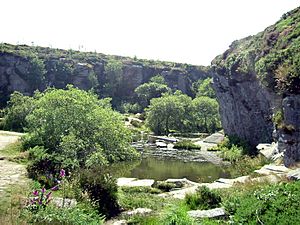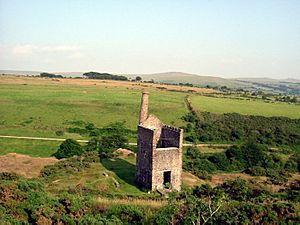Industrial archaeology of Dartmoor facts for kids
The industrial archaeology of Dartmoor is all about finding and studying the old buildings, tools, and places that show how people used to work and make things on Dartmoor. Today, only a few industries are still big there, like china clay mining, farming, and tourism. But in the past, many different jobs shaped the landscape we see now.
A good book to learn about these old jobs on Dartmoor is The Dartmoor Worker by William Crossing. It tells us a lot about what people did for work in the late 1800s.
Contents
Mining on Dartmoor
Long ago, people mined for lead, silver, tin, and copper all over Dartmoor. One of the easiest places to see evidence of this is the old engine house at Wheal Betsy. It's right next to the A386 road between Tavistock and Okehampton.
The word Wheal means a mine in Devon and Cornwall, usually for tin or copper. But at Wheal Betsy, they mostly dug for lead and silver.
Mining was very common on Dartmoor for a long time. But by the early 1900s, only a few tin miners were left. Twenty years later, almost all mining had stopped. Some important mines were Eylesbarrow, Knock Mine, Vitifer Mine, and Hexworthy Mine. The very last active mine in the Dartmoor area was Great Rock Mine, which closed in 1969.
Quarrying for Granite

The strong granite stone from Dartmoor has been used to build many structures in Devon and Cornwall. For example, the famous prison at Princetown was built using granite from Walkhampton Common. In 1823, a special horse tramroad was finished, connecting Plymouth to Princetown. This made it much easier to move large amounts of granite from the moor.
There were three main granite quarries on Dartmoor: Haytor, Foggintor, and Merrivale. The quarries near Haytor provided the stone for several well-known buildings. This includes the New London Bridge, which was finished in 1831. The granite for this bridge traveled from Dartmoor on the Haytor Granite Tramway. You can still see parts of this old tramway today!
The large quarries at Foggintor supplied granite for Nelson's Column in London in the early 1840s. Also, New Scotland Yard in London was built with granite from the Merrivale quarry. Merrivale Quarry kept digging and shaping its own granite until the 1970s. They made things like gravestones and rollers for farms. Work continued at Merrivale until the 1990s, but for the last 20 years, they worked with stone brought in from other places, like gabbro from Norway and marble from Italy.
Other smaller granite quarries were scattered around Dartmoor. Even unusual pink granite from Great Trowlesworthy Tor was quarried. Different types of rocks were also dug up around the edge of the moor, especially at Meldon.
Gunpowder Factory
In 1844, a factory was built on the open moor near Postbridge to make gunpowder. This gunpowder was very important for the tin mines and granite quarries that were active on Dartmoor at the time.
For safety, the factory buildings were spread far apart from each other. The machines that ground the powder were powered by waterwheels, which got their water from a special channel called a leat.
Today, this area is known as "Powdermills" or "Powder Mills." You can still see many parts of the old factory. Two chimneys are still standing. The strong walls of two "incorporating mills" (where the powder was mixed) are also well-preserved. These buildings had very strong walls but light roofs. This was so that if there was an explosion, the blast would go safely upwards. You can also see the ruins of other buildings that helped the factory run. A special small cannon, called a proving mortar, was used to test how strong the gunpowder was. It still lies by the road near the factory.
Peat-cutting for Fuel
People cut peat on Dartmoor for fuel until at least the 1970s. They usually cut it for their own use, not to sell. The right for Dartmoor commoners (people who live on the moor) to cut peat for fuel is called turbary. These rights are very old, even older than most written records.
An area called the Turbary of Alberysheved was mentioned in a document from 1240. This area was between the River Teign and the start of the River Bovey. By 1609, its name had changed to Turf Hill.
In 1901, someone tried to make cutting peat a big business at Rattle Brook Head, but it didn't work out and quickly failed.
Rabbit Warrens
From at least the 1200s until the early 1900s, rabbits were raised on Dartmoor for their meat and fur. We know this from old documents and place names. For example, Trowlesworthy Warren is mentioned in a document from 1272, and there's a famous pub called Warren House Inn.
You can also see physical evidence of these rabbit farms, called warrens. These are often in the form of pillow mounds, which are long, low mounds where rabbits would live. For instance, at Legis Tor Warren, there are 50 pillow mounds! The people who managed these warrens, called warreners, were quite clever. They even set up traps near the warrens to catch animals like weasels and stoats that tried to hunt the rabbits.
The word warren means something different today than it did long ago. In the Middle Ages, a warren was a special place. The king protected the animals in a warren for his own enjoyment.
The story The River by Eden Phillpotts talks about rabbit farming on Dartmoor.
Farming on Dartmoor
Farming has been happening on Dartmoor for a very, very long time. The dry-stone walls you see everywhere, separating fields and marking boundaries, show how much farming has shaped the landscape.
There isn't much growing of crops on the moor. Most of the farming is raising animals like sheep and cattle. This is because the soil is thin and rocky, which isn't good for growing plants. Some farms on Dartmoor are in very remote and isolated places.



